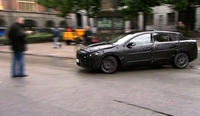Volvo Tests New, Unique Safety Technology in a Disguised S60 - VIDEO ENHANCED
 |
During this week, sharp-eyed citizens in Copenhagen have had the opportunity to get a sneak preview of the upcoming, sporty Volvo S60 - which won't be introduced to the world until next year.
GOTHENBURG - October 9, 2009: A disguised prototype of the new sedan model has been rolling through the streets of the Danish capital in order to test a groundbreaking new safety technology that can detect a pedestrian in front of the car and brake automatically if the driver doesn't react in time, to avoid an accident.
The new technology - Collision Warning with Full Auto Brake and Pedestrian Detection - will be introduced together with the all-new Volvo S60 in 2010. Volvo Cars' safety experts have been working with Pedestrian Detection technology for ten years and test cars have been rolling all over the world - most recently in the busy streets of Copenhagen.
Click PLAY to watch video
"Factors like traffic behaviour, road conditions and climate must be taken into account in the design of the final system. All told we have collected more than 500,000 kilometres of real-life data. We can also use the information from these traffic tests to conduct advanced computer simulations," says Thomas Broberg, Senior Safety Advisor at Volvo Cars.
The next step - protecting the unprotected
The new safety functions in
Collision Warning with Full Auto Brake and Pedestrian Detection represent
the next stage in Volvo Cars' continuous development of technology to
detect risky situations and help the driver mitigate or avoid accidents by
providing support in the decision-making process.
"The previous stages were developed to help the driver avoid collisions with other vehicles. Now we are taking a giant step forward with a function that also boosts safety for unprotected road-users. What is more, we are advancing from fifty percent to full automatic braking power. To the best of our knowledge, none of our competitors have made such progress in this area," explains Thomas Broberg. He adds: "This technology helps us take an important step towards our long-term vision of designing cars that do not crash. Our aim for 2020 is that no-one should be killed or seriously injured in a Volvo."
First a warning, then automatic braking
 |
In an emergency situation, the driver is first alerted by an audible warning together with a flashing light in the windscreen's head-up display. In order to prompt an immediate, intuitive reaction, the visual warning is designed to look like a brake light coming on. If the driver does not respond to the warning and the system assesses that a collision is imminent, the car's brakes are applied with full braking power.
"Active brake deployment requires that the object is confirmed by both the radar and the camera. Thanks to state-of-the-art sensor technology, it is now possible to engage full braking power," explains Thomas Broberg.
Accidents with pedestrians common in urban traffic
In the EU countries' capital
cities, 1,560 people died in road accidents in 2007. Of these, 43 percent
were pedestrians. The speed of the car is of considerable significance to
the outcome of an accident and the risk of a pedestrian being killed in an
accident at 50 kilometres per hour is 85 percent higher compared to if the
speed is 25 kilometres per hour.
"Our aim is that this new technology should help the driver avoid collisions with pedestrians at speeds below 25 km/h. If the car is travelling faster, the aim is to reduce the impact speed as much as possible. In most cases, we can reduce the collision force by about 75 percent. Considering the large number of pedestrian fatalities that occur, if we manage to lower the fatality risk by 20 percent this new function will make a big difference. In state-of-the-art sensor technology, it is now possible to engage full braking power," explains Thomas Broberg.


